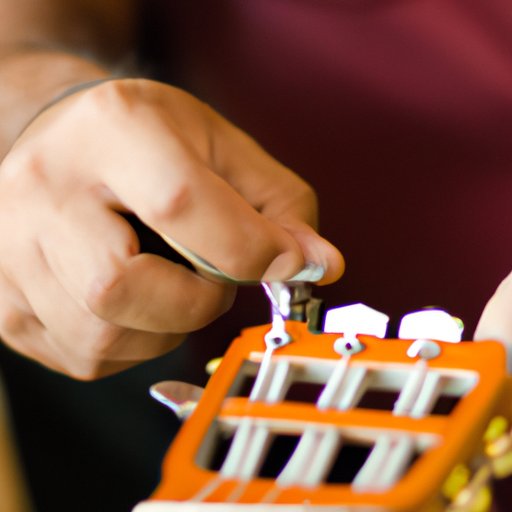
I. Introduction
Playing guitar can be frustrating if it’s not properly tuned. Tuning a guitar makes a significant difference in the quality of sound produced. A perfectly tuned guitar can make even the simplest chord sound amazing. In this article, we will guide you through the process of tuning a guitar. We will cover everything from using a tuner to ear training techniques.
II. Step-by-Step Guide
Tuning can be a daunting task for beginners. However, the process should not stress you, as it is not as complicated as it seems. First, ensure your guitar is in playing position. Follow these steps to tune your guitar:
- Start with the E string
- Pluck the E string
- Turn the peg clockwise or counterclockwise until the note produced matches the correct E
- Continue with the A, D, G, B, and E strings, in that order
- Keep checking the E string and make slight adjustments to the tuning pegs as you go along
You can use a guitar tuning app, a pitch pipe, or an electronic tuner to facilitate the tuning process. For beginners, we recommend using an electronic tuner since it is easy and accurate.
III. Using a Tuner
Electronic tuners are the most popular and efficient way to tune a guitar. They work by interpreting the sound produced by the guitar and indicating whether the note is sharp, flat, or in tune. There are several types of tuners:
- Clip-on Tuners – These are attached to the headstock or the body of the guitar and detect pitch through vibration.
- Pedal Tuners – These are placed on the pedalboard and are suitable for stage performance.
- Smartphone Apps – These use the phone’s microphone to analyze the pitch of each string.
Using a tuner is simple. Tune each string of your guitar until the needle or digital display is pointing to the center of the gauge. This indicates that the string is in tune.
IV. Alternate Tuning
Standard tuning is not the only way to achieve excellent sound. Alternate tunings can add depth and character to your music. Here are a few alternate tunings:
- Dropped D – Tune the sixth string down to D. Used in rock, blues, and metal.
- Open C – Tune the guitar to the C Major chord. Used in blues and folk music.
- DADGAD – Tune the guitar to DADGAD. Used in Celtic, folk, and fingerstyle guitar.
You can find online resources that will give you more information on alternate tunings and how to achieve them.
V. Ear Training
Tuning by ear is a valuable skill for any musician. It cultivates your listening skills and enhances your musical abilities. Some common methods of ear training include:
- Relative Tuning – Here you tune one string to another. This method is common among beginners.
- Open Tuning – Here you create a chord with the open strings.
You can find more resources online that will help with ear training.
VI. Electric vs. Acoustic
Tuning an electric guitar and an acoustic guitar is not different. The only difference may come in the use of different methodes of tuning. With an electric guitar, you can use a pedal tuner connected to your guitar to help tune the instrument. For acoustic guitars, you can also use pedal tuners but it can be difficult in the stage. Clip-on tuners work best for managing the guitar reverberation.
VII. The Importance of Tuning
Tuning a guitar is an essential part of playing as it impacts the sound quality produced. When playing with other musicians, being out of tune can ruin the sound of the whole group. If you plan to record yourself playing, it’s important to tune your guitar to get the best quality sound. Also, playing an out-of-tune guitar can damage the instrument over time.
VIII. Common Mistakes
Tuning can be confusing, and many beginners struggle with it. Common mistakes include:
- Pushing too hard on the tuning pegs
- Not fine-tuning each string
- Not tuning all strings in the proper order
- Not checking the tuning regularly during playing
To avoid these mistakes, take your time when tuning and use a tuner if possible. Checking your tuning regularly during playing ensures that the guitar maintains correct tune throughout the performance.
IX. Conclusion
Tuning your guitar is an essential part of playing an instrument. It is easy to tune your guitar if you follow the right process. Remember to practice frequently to become proficient in tuning. Even if you are using electronic tuners, cultivate your ear to enhance your musical skills.





